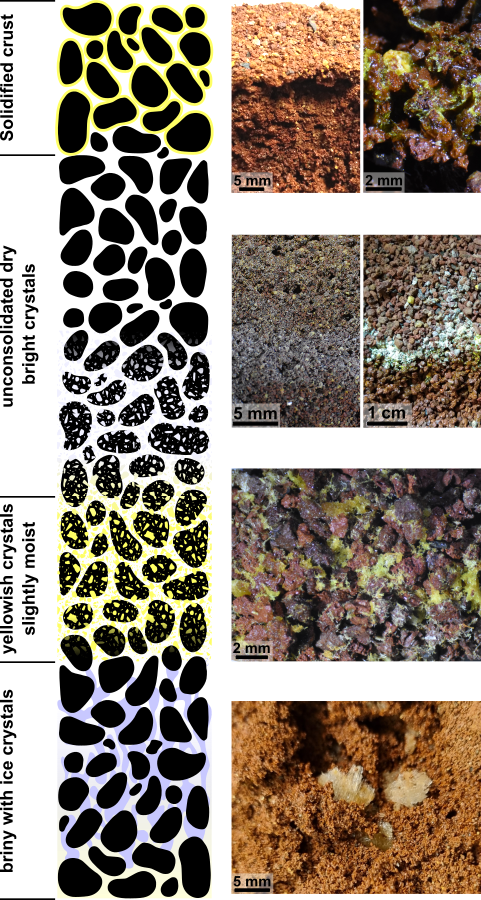Evolution of brines in regolith analogue under simulated Martian surface conditions
- SRT, Luleå University of Technology, Space Campus, Kiruna, 981 92, Sweden
Introduction
Sublimation experiments performed in vacuum chambers have proven useful for understanding the processes that occur on the surfaces of volatile-rich celestial bodies without significant atmospheres [1, 2, 3]. To date, these experiments have focused on the sublimation of volatile ices without considering the possibility of a liquid phase being present. The most prominent example is Mars, the surface of which appears as an ultra-arid cold desert nowadays, but the presence of liquid water in its past is essentially assured [4, 5].
On Mars, impact events or seasonally increased insolation might locally thaw near-surface permafrost and release liquid water, even long after transitioning from a more humid to an ultra-arid and low-pressure environment. The liquid water could solute and transport salts away from one location to another, where they could form deposits after the eventual evaporation of the water.
Suppose salt crusts or related morphological features of the Martian surface can be reproduced in sublimation chambers using saline solutions and regolith analogues. This would shed light on how salt deposits on Mars formed after the planet lost most of its atmosphere.
Scientific objectives are:
- What physical environmental parameters and chemical composition affect the sustainability of surface-near aqueous solutions in a cold, low-pressure environment?
- Does liquid water sublimate from the sample surface and form salty crusts or efflorescences?
- Do saline ices and brines form near-surface features such as ice lenses?
Methods
In a vacuum sublimation chamber, environmental conditions on the Martian surface were reproduced, and the conditions under which saline solutions can migrate through a regolith analogue were investigated. The focus was on the parameters of salt composition and concentration, as well as the grain size of the regolith analogue. In particular, Mg2+, Fe3+, Cl-, and SO42- based salts were used since they are observed in specific areas of the Martian surface [6, 7].
Mars regolith analogues were saturated with brines and placed in a transparent sample container in a sublimation chamber. The environmental conditions in the chamber were adapted to the Martian summer and account for 243 K temperature, 5 mbar atmospheric pressure, and 600 Wm-2 irradiance.
Each experiment lasted several days, during which the lateral and horizontal sample surfaces were permanently monitored with cameras. After completing the sublimation experiments, the sample's internal layer structure was analysed. The reflectance of each sample surface was measured in the spectral range of 400-2500 µm. Eventually, the cone tip penetration method was used to test the resistance of the surface to mechanical stress.
We carried out experiments on two scenarios with different salt concentrations, in which the grain size of the regolith analogue was varied at low and high salinity. The used grain sizes were 212-500 µm, 1000-2000 µm, and 212-2000 µm.
Results
After the sublimation experiments, the samples generally presented four different layers (Fig. 1).
- A solidified crust formed on the surface. The thickness of the crust was determined by the grain size, whereby the thicknesses increased with increasing grain sizes. With increasing grain size, the crust's cone tip resistance (CTR) was reduced by an order of magnitude, respectively. However, the resistance to mechanical stress also depended strongly on the salinity. For the same grain size, the CTR for the high salinity scenario was about one magnitude higher than in the low salinity scenario. Analyses of the reflectance spectra showed a clear blue slope of salt-rich surfaces, which became more distinct with decreasing regolith grain size (Fig. 2). However, no pure salt deposits could be produced on the surface, even in the high salinity scenario.
- Below the crust, a layer of dry, unconsolidated material formed. Notably, in the samples of the low salinity scenario, salt crystallised and gave the layer a bright appearance.
- Then, a slightly moist layer followed, and dark-yellowish crystals formed. The thickness of the layer was comparable for both salinities and only increased slightly with increasing grain size.
- The bottom layer was moist with brines and contained considerable quantities of water ice crystals. The depth at which this layer formed was determined by grain size, not salinity. Small grain sizes favoured the formation of larger ice crystals, which grew to 5 mm in size. The ice crystals were clear and had a lower salt content compared to the initial solution.

Fig 1: Schematic representation of the resulting layers after completion of the sublimation experiments. The camera images show examples of the layers with various grain sizes and salinities.
Fig 2: Reflectance spectra of sample surfaces with a regolith grain size of 212-500 µm. With increasing salinity of the sample, the spectra show a distinct blue slope.
References
[1] Poch, O., et al. 2016, Icarus, 267, 154-173. doi:10.1016/j.icarus.2015.12.017
[2] Mc Keown, L.E., et al. 2017, Sci Rep 7, 14181. doi:10.1038/s41598-017-14132-2
[3] Haack, D., et al. 2021, Astronomy & Astrophysics, 649, A35. doi:10.1051/0004-6361/202140435
[4] Irwin III, R.P., et al. 2004, Journal of Geophysical Research: Planets, 109(E12). doi:10.1029/2004JE002287
[5] Wray, J., 2021, Annual Review, 49, 141-171. doi:10.1146/annurev-earth-072420-071823
[6] Mangold, N., et al. 2008, Icarus, 194, 519-543. doi:10.1016/j.icarus.2007.10.021
[7] Osterloo, M.M., et al. 2008, Science, 319(5870), 1651–1654. doi:10.1126/science.1150690
How to cite: Haack, D., Kaufmann, E., and Hagermann, A.: Evolution of brines in regolith analogue under simulated Martian surface conditions, Europlanet Science Congress 2024, Berlin, Germany, 8–13 Sep 2024, EPSC2024-85, https://doi.org/10.5194/epsc2024-85, 2024.